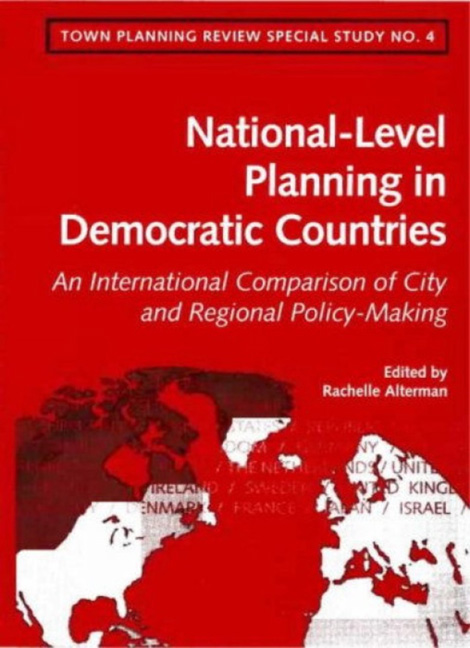 National-Level Spatial Planning in Democratic Countries
National-Level Spatial Planning in Democratic Countries Book contents
- Frontmatter
- Dedication
- Contents
- List of Figures
- List of Tables
- Preface
- About the Contributors
- 1 National-Level Planning in Democratic Countries: A Comparative Perspective
- 2 National Land-Use Planning and Regulation in the United States: Understanding its Fundamental Importance
- 3 Structures for Policy-Making and the Implementation of Planning in the Republic of Ireland
- 4 Rethinking Swedish National Planning
- 5 National-Level Institutions and Decision-Making Processes for Spatial Planning in the United Kingdom
- 6 National-Level Planning Institutions and Decisions in the Federal Republic of Germany
- 7 National-Level Planning in the Danish System
- 8 National-Level Planning Institutions and Decision-Making in France
- 9 National-Level Economic and Spatial Planning in Japan
- 10 Dutch National Planning at the Turning Point: Rethinking Institutional Arrangements
- 11 National-Level Planning in Israel: Walking the Tightrope Between Government Control and Privatisation
Preface
- Frontmatter
- Dedication
- Contents
- List of Figures
- List of Tables
- Preface
- About the Contributors
- 1 National-Level Planning in Democratic Countries: A Comparative Perspective
- 2 National Land-Use Planning and Regulation in the United States: Understanding its Fundamental Importance
- 3 Structures for Policy-Making and the Implementation of Planning in the Republic of Ireland
- 4 Rethinking Swedish National Planning
- 5 National-Level Institutions and Decision-Making Processes for Spatial Planning in the United Kingdom
- 6 National-Level Planning Institutions and Decisions in the Federal Republic of Germany
- 7 National-Level Planning in the Danish System
- 8 National-Level Planning Institutions and Decision-Making in France
- 9 National-Level Economic and Spatial Planning in Japan
- 10 Dutch National Planning at the Turning Point: Rethinking Institutional Arrangements
- 11 National-Level Planning in Israel: Walking the Tightrope Between Government Control and Privatisation
Summary
This book would not have come about were it not for a particular event—one might say, a coincidence—which brought to my attention the need to study national-level planning. A major crisis in Israel brought to the front burner the need for multi-sectoral long-range planning at the national level.
The crisis arose from external events. During the last months of the Soviet Union, international conditions changed, and mass emigration of Jews and family members was allowed. The estimate in 1990 was that within three to five years, Israel, with a population of 4.5 million at that time, should expect to take in 1.5 to two million people. Understandably, a feeling of crisis overtook government bureaux which were concerned about the impact of such an avalanche on housing, land use, the environment, economic development, and many more issues.
Although national-level planning institutions and powers were—and still are— ample in Israel, by 1990, long-range multi-sectoral planning at the national level, which had its heyday in the 1950s and 1960s, had become a distant memory, gradually withering away. A team of planners and academics decided to take the initiative and show government the way. The team was headed by Adam Mazor, a leading planner-architect and professor at the Technion-Israel Institute of Technology, where the country's major planning school resides. At first regarded as an academic-professional project outside government, the ‘Israel 2020’ project was later adopted by a consortium of government bureaux, while still maintaining its out-of-government status.
The ‘Israel 2020’ project (described in detail in Chapter 11) took it upon itself to create a new style of planning at the national level: no longer a blueprint land-use plan and command-style implementation system that Israel was still carrying from the 1950s, but a new style that would take Israel into the twenty-first century. We were attempting to create an integrated policy covering land use, infrastructure, economics, environment, water, agriculture, and social policy.
New modes of plan-making would not be enough; there should also be new ways of institutionalising national-level planning so as to fit better with the trends of deregulation, privatisation and changes in governance styles that Israel, like most other advanced-economy countries, was undergoing. We were therefore seeking to know more about alternative modes of national-level planning as carried out in other democratic countries, and it was my role in the team to find out.
- Type
- Chapter
- Information
- National-Level Spatial Planning in Democratic CountriesAn International Comparison of City and Regional Policy-Making, pp. xi - xiiPublisher: Liverpool University PressPrint publication year: 2001


